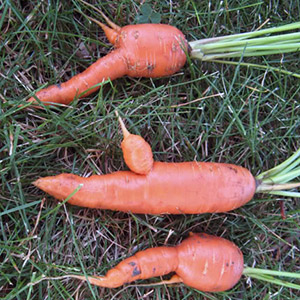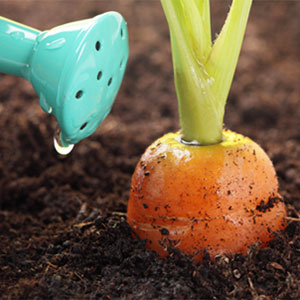Reasons why carrots are gnarled and horny and methods of growing even root crops
Carrots are an unpretentious vegetable, but their cultivation requires adherence to basic agrotechnical rules. Getting crooked and horny crops is not uncommon. There are many reasons for deformed root crops: from improper watering to plant diseases.
How to grow smooth, beautiful carrots? Let's talk about this in the article.
The content of the article
Reasons why carrots are horny and clumsy
After sowing seeds and long-term care of the vegetable, you want to get a high-quality harvest. But what if reality doesn't live up to expectations? First, it is worth figuring out why this is happening.
The main reasons why carrots grow crooked:
- unsuitable soil structure for growing carrots;
- errors in the use of fertilizers;
- excessive watering or, conversely, its absence;
- mechanical damage to root crops;
- close distance between plants;
- wrong choice of variety.
Unsuitable soil
Loose soils are chosen for growing carrots: light and medium loams, peat and sandy soils.
Important! The humus content in the soil is at least 4%.
Why heavy soil is unsuitable for growing root crops:
- The structure is too dense. The root will not have enough strength to break through the dense layer of earth, and it will start looking for side passages in the ground.
- In dense soil there are mechanical barriers - stones, remnants of the root system, branches. All this prevents the main root from fully developing.
Fertilization errors
A place for sowing a vegetable is prepared in the fall. In the same period, it is recommended to fertilize the soil with organic fertilizers.
Fertilizer application errors:
- excessive feeding;
- introduction of fresh manure at the root;
- simultaneous introduction of lime and nutrients.
Important! Dolomite flour and potassium chloride have a negative effect on carrots. When used, the root crop dries up and cracks.
For the correct development of carrots, 2-3 dressings are carried out per season.
Fertilization steps for carrots:
- Organic matter is introduced in autumn.
- In the spring, two weeks before sowing, nitrogen and phosphorus fertilizers are applied.
- First feeding. When 2-3 true leaves appear. Based on 10 m of the ridge, 25 g of ammonium nitrate, 35 g of superphosphate and 30 g of potassium salt are diluted in 10 liters of water.
- Second feeding. Three weeks later - similar to the first.
- Third feeding. It is applied for late varieties. In this case, 35 g of superphosphate and 30 g of potassium salt are diluted in 10 liters of water.
Important! To prevent washing out of the introduced nutrients, feeding is carried out after watering or after rain.
Improper watering
Untimely watering also contributes to the deformation of the root crop.
Insufficient or uneven watering is fraught with consequences:
- cracking of the vegetable, which leads to the bifurcation of the carrot;
- in the absence of moisture, the plant enhances the growth of lateral shoots in search of water.
Rules for watering carrots:
- in the first month after sowing, regular abundant watering as needed;
- during the period of carrot formation, watering is halved;
- from August, the formation of a root crop ends - they exclude watering for good.
Observe the ratio of regularity and watering depth: it is better to water less often, but distribute water more evenly over the surface of the garden, thus increasing the depth to the optimal 20-30 cm.
Root damage and other causes
Mechanical damage to the roots is a common cause of vegetable ugliness.
Causes of damage:
- rough, sloppy weeding;
- vegetable transplant;
- lack of moisture in the soil at the beginning of development;
- impact pests.
To prevent defects, you need:
- carefully look after crops;
- treat pests;
- follow the sowing rules and in no case transplant carrots.
Another reason for the deformation of carrots is the violation of the distance between crops. With excessive distances, the feeding area of the root system increases, as a result of which the lateral roots grow. In turn, planting too close reduces the feeding area, and carrots interfere with each other's development.
Wrong variety selection - one of the main causes of curvature of the root crop. The problem lies in the discrepancy between the growing conditions required for the variety and the actual climatic conditions.
Council. Choose zoned varieties.
What to do
To solve the problem of clumsy carrots, follow the rules of care and agricultural technology.
Stages of solving the problem:
- Autumn soil preparation. After harvesting the previous crop dig up the garden. To improve the soil structure, green manure is sown.
- Dig up the soil again in the spring. The procedure is carried out two weeks before sowing with the introduction of mineral fertilizers.
- After sowing, do not allow the soil to dry out.
- When the carrot begins to form, thinning of crops is carried out, if necessary.
- Carry out timely weeding of crops.
- Harvesting crops. When carrots are in the soil for a long time after ripening, they begin to crack and rot.
How to grow smooth, beautiful carrots
To get a good quality carrot harvest, you should pay special attention to two stages of plant development.
Two critical stages in the development of carrots, at which the root deforms:
- First stage... Curvature occurs due to lack of moisture, heavy soils and excess nitrogen.
- Second half of the growing season. At this stage, horniness of carrots is more often formed due to a lack of moisture.
It is important to observe the sowing time to obtain a high-quality crop. If the temperature after sowing is below + 8 ° C, the probability of deformation of root crops increases. If the temperature is above + 25 ° C, then the development will slow down.
Important! For winter sowing, special varieties of carrots are chosen. Since the soil settles in winter.
The choice of location also affects the increase in the quality of the crop. Consider the following cultural features:
- the garden bed is placed in a lighted place;
- use loose soil with neutral acidity;
- follow the rules crop rotation: the best predecessors are potatoes, onions, tomatoes.
Another important point when growing carrots is preparing the seeds for sowing. To get friendly shoots of carrots, use the following methods of seed preparation:
- Soaking method. Prepare a solution: 0.5 tsp. complex fertilizer and 0.5 tsp. potassium permanganate is dissolved in 1 liter of water. The seeds are soaked for a day in this solution, after which they are sown.
- Hardening method. The seeds are placed in a cloth and a week before sowing, I bury them in the ground to a depth of 20 cm. The seeds are taken out on the day of sowing, dried and sown.
To avoid thickening of crops, they are drained or purchased ready-made.
Important. The belt sowing method is also used. Seeds are glued on a tape of paper at a distance of 7-10 cm, the tape is laid in a row.
Secrets of growing even, beautiful carrots:
- comply with the rules of agricultural technology;
- do not sow carrots after spicy herbs;
- slightly huddle crops after weeding;
- take care of crops in a timely manner;
- follow the rules of watering;
- process crops from diseases and pests.
Tips from experienced summer residents
Experienced summer residents share their methods of solving the problem of carrot deformation.
Basic tips:
- Choose the right predecessor. Suitable for carrots are potatoes, tomatoes, legumes and cucumber. Plant carrots in their original place in at least a year.
- Do not apply organic fertilizers under the carrot.The root crop begins to deform.
- Follow the landing pattern. The distance between carrots is about 10 cm, and the row spacing is at least 25 cm.
- Be sure to adhere to the rules of watering, weeding and do not forget to thin out the carrots in time.
Conclusion
To solve the problem of deformation of the root crop, you need to know the basic rules of crop care. If you follow agricultural techniques, you will be able not only to avoid the ugliness of the vegetable, but also to improve the quality of the crop.